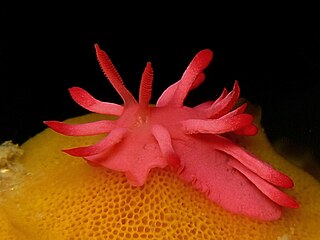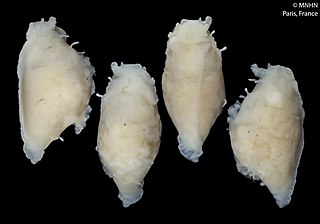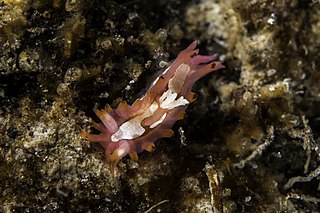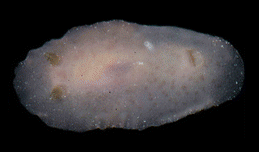
Doto pita is a species of sea slug, a small nudibranch, a shell-less marine gastropod mollusc in the family Dotidae.

Okenia is a genus of colorful sea slugs, specifically of dorid nudibranchs, marine gastropod mollusks in the family Goniodorididae.

Discodoris branneri is a species of sea slug, a dorid nudibranch, shell-less marine gastropod mollusks in the family Discodorididae.

Felimida clenchi, common name the Harlequin blue doris, is a species of colorful sea slug, a dorid nudibranch, a marine gastropod mollusk in the family Chromodorididae.

Tyrinna evelinae is a species of sea slug or dorid nudibranch, a marine gastropod mollusk in the family Chromodorididae.

Coryphellina marcusorum, is a species of sea slug, an aeolid nudibranch, a marine gastropod mollusc in the family Flabellinidae.

Flabellina engeli is a species of sea slug, an aeolid nudibranch, a marine gastropod mollusc in the family Flabellinidae.

Okenia zoobotryon is a species of sea slug, a dorid nudibranch, a marine gastropod mollusc in the family Goniodorididae. It is normally found on the colonial bryozoan Amathia verticillata on which it lives and feeds.

Okenia angelensis common name Los Angeles Okenia, is a species of sea slug, specifically a dorid nudibranch, a marine gastropod mollusc in the family Goniodorididae.
Okenia kendi is a species of sea slug, specifically a dorid nudibranch, a marine gastropod mollusc in the family Goniodorididae.

Okenia liklik is a species of sea slug, specifically a dorid nudibranch, a marine gastropod mollusc in the family Goniodorididae.
Okenia hiroi is a species of sea slug, specifically a dorid nudibranch, a marine gastropod mollusc in the family Goniodorididae.
Okenia impexa is a species of sea slug, specifically a dorid nudibranch, a marine gastropod mollusc in the family Goniodorididae.
Okenia vancouverensis is a species of sea slug, specifically a dorid nudibranch, a marine gastropod mollusc in the family Goniodorididae.
Trapania maringa is a species of sea slug, a dorid nudibranch, a marine gastropod mollusc in the family Goniodorididae.
Polycera aurisula is a species of sea slug, a nudibranch, a marine gastropod mollusk in the family Polyceridae.

Jorunna spazzola is a species of sea slug, a dorid nudibranch, a shell-less marine gastropod mollusc in the family Discodorididae.

Eubranchus conicla is a species of sea slug or nudibranch, a marine gastropod mollusc in the family Eubranchidae.

Pleurobranchus areolatus is a species of pleurobranchid sea slug, a type of marine gastropod mollusc, commonly found in the Caribbean Sea. It is up to 15 cm long and it feeds on ascidians.

Doto chica is a species of sea slug, a nudibranch, a marine gastropod mollusc in the family Dotidae.













